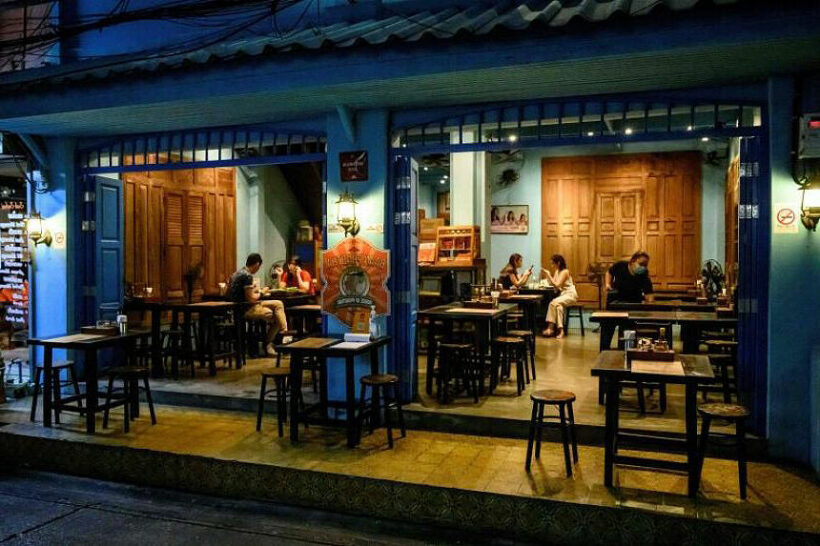OPINION: Why restaurants are so f**ked

Article by Guest Blogger Joelle Parenteau
(This article contains some strong language that may offend some people)
Covid 19 is about to kill restaurants by the thousands. This pandemic is the ultimate pressure test and restaurants are failing hard. Think about it: when we come out of this, your favourite food spots might not be there any more. Why are they so fucked? Let me explain.
Margins in the restaurant industry are notoriously small. Like tiny, actually. For reference, margins for banking, accounting, and legal services come in around 18–25%, healthcare 12-15%, and software 15–25%. Restaurants? 3–9%. Ya, like single digit.
These razor thin profit margins have left restaurants with zero reserves. So when a crisis hits (like right now), they are pretty much screwed. Restaurant owners’ only options are to swallow their pride, beg, and hope for help — or throw in the proverbial dish towel. Did you realize how many restaurants don’t even have one months rent in the bank? It’s bananas!
So, why are the margins so bad anyway? Well, it starts with the fact that the industry as a whole shot itself in the foot when it started competing on price. See, it wasn’t always this way — margins used to be double, if not triple, what they are now. But for the past couple decades, while menu prices should have been rising to keep up with things like inflation and rapidly increasing rent, price wars instead drove them down ($1 value meal anyone?). All this eroded margins til restaurants were left with nothing but bread crumbs.
This failure to manage expectations has simultaneously obliterated margins, all the while skewing and reinforcing our perception of what food should cost.
“Even widely lauded restaurateurs are taking ever-smaller earnings. The 15-20% margins of 20 years ago have dwindled to a mere 4-7% today.” — Philly Mag
That brings me to my next point: our lack of understanding or appreciation of the true cost of running a food operation. We just don’t know. And our assumptions are way off. To be honest, I didn’t know most of this either before I opened Wolf Down (quick serve German Street Food). And let me tell you, it was quite the eye opener! I’ll share what I discovered through my experience to shed light on why restaurants are so fucked, why we are (at least in part) accountable, and how we have the power to fix it.
First we need to understand how restaurant margins work. Don’t worry, I’ll keep it simple. Profit margin is what’s left of sales revenue after subtracting all expenses to get food into your belly. This includes food cost (COGS), labour cost, and overhead. It seems pretty straight forward at first, but there are a lot of hidden costs that might surprise you. I’ll share just a few that I’d never even thought about before Wolf Down.
Food cost obviously includes all the ingredients. What we often forget though are things like waste and packaging cost, which can add up fast. Our take-out bowls, for example, cost $0.35 each. Add a fork, bag and napkins and that’s a nice little bite out of our profit margin.
I was also somehow convinced that getting product from big food suppliers would be cheaper since we buy in bulk. Apparently that’s not always the case. For some things yes, but for others, they up-charge. Drinks for instance cost us more than at the grocery store — but we can’t exactly go get 20 cases of pop per day, so we don’t have much choice.
In terms of overhead costs, there’s the obvious stuff like rent, utilities, insurance, internet, bookkeeping, payment processing, etc. Then there’s all this other stuff I’d never thought about — like $300/month for waste management (we’re so used to free garbage pick-up at home that I never anticipated having to pay for it). Then there’s $150 for linen service to wash all the cleaning towels, another $150 for dishwasher rental, another $150 for grease trap servicing, and don’t forget hood fan servicing, security, etc, etc.
All-in, food cost generally eats up around 33% of revenue, labour chews up another 33%, and hopefully overhead is low enough to have leftovers. Ratios vary based by restaurant type, but profit margins usually land around 3–9%. To help illustrate this, I put together a rough breakdown of costs for a döner at Wolf Down to give you an idea of how it all breaks down.
In our case, food cost is higher than recommended due to our bread and proteins. We wanted the best, freshest sourdough for our döner bread, so we partnered with Artisin who bakes it custom for us. This is much pricier than pre-packaged pitas but, based on the raving reviews, totally worth it. As for the protein, not only do we use high quality stuff, but contrary to many spots these days, we don’t skimp on protein. Most places average 75–100g per portion. We go over 125g. Cause that’s what a döner should be. We aim to satisfy.
Since we refuse to sacrifice proper portions and product quality, I knew we had to find other ways to keep costs down. We designed our streamlined menu precisely for this — optimising operating costs to compensate for food cost. Still, as you can see, after wolfing down, there isn’t much left. Roughly a dollar or so. That means we need to sell a whole lot of döner to make a little profit. All I’m trying to say is, no one is making millions here, just trying to save up a little something in the bank in case of, you know… a pandemic?
Ok so, how can we lower costs? Other than expanding to take benefit from economies of scale (ie. why big chains are doing ok), the options, well, you’re not gonna like them…
Option 1: Lower food cost. Lower quality ingredients cost less. But wait, they also won’t be as fresh or tasty. You cool with that? Restaurants already do all they can to negotiate with suppliers to lower cost — and when they go too far, it shows. Personally, it makes me want to cry when my favourite sandwich spot replaces its fresh crusty sourdough for bagged pre-sliced Wonder trash. But I get it. Though in my head I’m yelling ‘I’ll pay for the good shit —please, bring it back!’. So ya, this option sucks.
Option 2: Cut overhead costs. Again, restaurants do their best to negotiate with landlords, insurance companies, utilities, internet providers… and we all know how well that tends to work. If you want a nice clean dining experience — it is what is, and it costs what it costs. Not much wiggle room here.
Option 3: Reduce labour cost. How long do you want to wait for food? Is it ok if it’s not cooked perfectly cause one guy is trying to do five things at once? Besides, it’s not like we can we pay them any less — most make minimum wage. If anything, we don’t pay them enough. If you think they are ‘non-skilled workers’ — are you saying feeding you is not a valuable skill? I’ve worked with great people in tech and finance, but they’re no better or harder working than our Wolf Pack. This stigma has got to go. You get what you pay for.
“In most people’s opinion, an office job is preferable to a career in the restaurant industry. Which is not to say it’s not worthy work. If this pandemic has proven anything, it’s how essential those working in the food industry are. Instead, these assumptions come from a cycle of low pay and bad benefits that devalue both the job itself and the people doing it.” — Eater
And in case anyone is wondering “Then how come Wolf Down can afford to feed healthcare workers for free?” What’s the deal? Fine. For the sake of this post, I’ll come clean: it comes from our (the owner’s) pockets, not Wolf Down’s.
What about third-party delivery? Do they help or hurt restaurants? That’s a whole other conversation I dive into in my post ‘Why Uber Eats is A Necessary Evil’ — check it out if interested in learning more about that.
How about tips? Tips are hugely appreciated and really help staff survive, which is awesome. Unfortunately, however, tips do not impact margins. Even though tipping generously is always commendable — please keep it up!—it does not solve the problem. So what do we do?
Desperate times call for desperate measures. Although we can’t change the past, we can reshape the future. Let’s learn something from Covid 19. Let’s create positive change out of a bad situation and finally fix this mess. If you love food as much as I do, you might want to pay attention.
Whenever the margin issue comes up, the answer always seems to be ‘just lower costs’. Like duh. But wait! We already trimmed all the fat… Decreasing costs won’t solve this. That leaves only one option: increasing sales revenue. We’ve been looking at it all wrong. The simple truth is we don’t pay enough. Without realizing it, we’ve been cheaping out on restaurants.
The craziest thing to me in all this is, I love food. Like, obsessed. Who’s with me? My point is: if eating is literally one of our favourite things ever, are we willing to pay adequately for it? Do we value it sufficiently? Honestly, seems to me like, if there’s one industry that should be profitable, it’s restaurants. One, we have to eat. Two, we love to eat! What if you could never have your favourite pizza, burger, pasta, etc, again? What would you pay to save it?
Reports show that, due to Covid 19, 1 in 10 restaurants is already gone for good. And this is just the beginning. When restaurants do re-open (those that survive), they will be in rough shape. This is when we need to step up to ensure that those who put food on our tables can keep food on theirs.
Let’s call it OPTION 19. As in, we already tried all the other options and none work. As in, fuck you Covid 19! It’s very simple: let’s reset our expectations and restore respectable margins. Like back in the 1990’s. Like many other industries today. We can do better. They deserve better. Let’s aim for 19%.
How do we do this? By supporting your favourite restaurants increasing menu prices. That’s it. For too long they’ve avoided doing this out of fear that we would rebel. Armed with new knowledge, let’s be more understanding. That’s how we #supportlocal. That’s how we keep enjoying our favourite foods. It won’t kill us. It will save them.
Who’s in?
 Read more of Joelle’s articles HERE. Original article HERE.
Read more of Joelle’s articles HERE. Original article HERE.
Tell us what you think in our Thaiger Talk section.
Latest Thailand News
Follow The Thaiger on Google News:


























